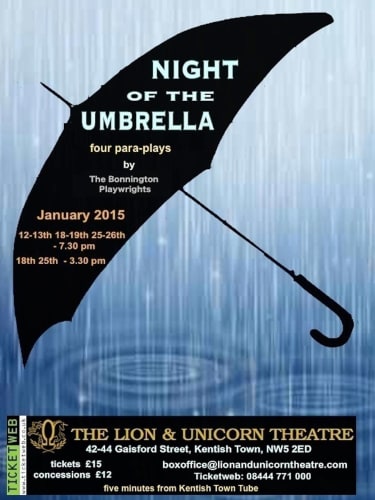Night of the Umbrella is described by its presenters as four para-plays. That presumably is para as in parasol meaning protective, rather than other senses such as a small coin or defective or abnormal.
I don’t see what they are protecting but they are certainly not defective and if abnormal embraces an odd quirkiness that’s fits these four playlets and their quirkiness is intriguing.
They are written by four different playwrights who have given themselves the challenge of each writing a play that features an umbrella and they have come up with four very different stories and styles. Four plays and four writers is matched by them each being written for a quartet of actors and that gives each player the opportunity to display his or her range in four different characters.
John Thane’s Raining in My Heart is perhaps the most straightforward. TV economics reporter shares her umbrella with a young man whose own has been destroyed by the wind. He chats his way into her house and there makes advances that lead to a compromising situation involving the police and her MP husband.
It's a classic example of how a well-meant action can backfire with some sly digs at newspaper opportunism and politicians' private lives and a twist at the end. It seems to be meant as comedy rather than political comment and needs more subtle performances to make that work, though Rebecca Bell hits the right note in playing a young PC without exaggeration and Richard Ings is a level-headed politician.
Richard White’s The Cure takes the slightly surreal edge of the first play much further in a tale of a man with a strange illness that sprouts (among other things) umbrellas. Is this physical or psychosomatic? There is a political nod to NHS pressures and a scathing glance at doctors' own priorities through Rebecca Bell’s GP super-jogger and Liran Nathan’s registrar who finds interesting symptoms more important than patients, while Ings has the chance to be totally zany.
On a Dark and… by Tom MacAskill uses an umbrella as a link between worlds as Nathan’s suicidal city finance worker encounters Bell and Margaret Ashley as Second World War ghosts mourning their own failures under black crepe draped brollies, which produces some strong images and an eerie atmosphere if thin on storyline.
The final play, Camille’s Parasol by Ros Conford, features no fewer than four parasols in a playlet about one that has gone missing. That missing parasol is believed to be one that appeared in Renoir’s painting Les Parapluies. A young man (Nathan), his girlfriend (Bell) and his mother (Ashley) are all seeking to replace it and return it to his grandmother (an autocratic Ings in drag) with grandma capping the development with further revelation.
Conford incorporates a brief dream sequence in which the man is visited not only by Camille (Bell creating a memorable picture in a poppy-decorated dress that trails across the stage) but also by a succession of painters: Monet, Magritte and Picasso, each in appropriate style.
These aren’t ground-breaking plays, and don’t pretend to be, but a rather tongue-in-cheek way of addressing the task these writers set themselves. With simple resources, director Katerina Jugati has given them a stylish presentation, preceding and linking the plays with well-chosen music that all features umbrellas.
At its first performance in front of an audience, some of the plays had not quite matched their playing to the size of the venue, but that didn’t stop them getting an enthusiastic reception.
